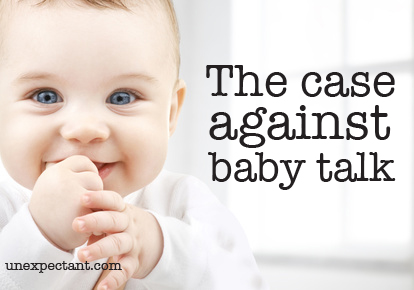Recently, I was minding my own business, attempting to get a bit of reading done, while the kids tumbled around at gymnastics. But, soon something grabbed my attention. I tried to ignore it. Like fingernails on a chalkboard or a broom sweeping across carpeting, I wanted to ignore it, but the sound would not go away. It was unrelenting. It was a mother speaking with her child in baby talk.
I realize the mother was attempting to speak with her three- or four-year-old child in a sweet manner, but I so badly wanted to turn to her and say, “Use. Your. Words.” Instead of real words, she rambled in high-pitched gibberish and made up words, something along the lines of putting on a “coaty-woaty” to “go bye-bye car.”
The next week a similar situation took place and that got me to wondering: is baby talk just a pet peeve of my writer’s mind? Or is it more advantageous for parents to use correct grammar with children, even at a young age? To figure this out, I turned to Kris Arizmendi, coordinator for the Talk With Your Baby program in South Bend, IN. Kris works to help parents engage their babies and encourage brain development through communication.
“We encourage that all children have an opportunity to learn and excel in their early years and onward, no matter their background,” Kris said. “As parents, if you are constantly having conversations, reading and singing with your children, they’re off to a good start for success later in life.”
In the article “How to Talk with Your Baby…and Make Her Smart,” Kris also said:
Research has shown that children from talkative families have heard 30 million more words by age 3 than children from less talkative families. The more words these children heard, the better they did on tests of cognitive development and the better they did on reading readiness tests in the third grade. No fancy flashcards or expensive DVD sets are necessary. Talking, reading and interacting with your child right from the start and at every chance you get is the best thing you can do for her in this critical developmental stage.
To get a good start during that critical developmental stage, Kris suggests parents follow these steps:
Use real words.
“We suggest that you use real words and correct grammar when speaking to your children. Baby talk, as opposed to clear, English words, is not as easy for babies to understand. If you find yourself using baby talk occasionally, that’s okay. For your child to develop a good base for literacy, however, it is important for you to speak to her in correct language when you’re labeling objects, people and other things in her life.”
Practice parentese, not baby talk.
“Baby talk is not nearly as beneficial as parentese, although the two are often confused. Baby talk is the use of made up sounds or words (‘goo goo ga ga’) in place of real words or phrases. Parentese, on the other hand, is the use of a high-pitched voice coupled with elongated syllables when speaking. It has been shown to be instrumental in helping babies learn the basic phonics of language.”
Do more than just talk.
“We suggest repetition and different methods of talking, such as reading and singing. We also advocate that one’s tone and message should always match, so that children are able to distinguish between different emotional states, such as happiness or frustration. Humans are constantly learning and communicating, even if that communication may not be verbal. Although it may not seem like your baby is understanding your words, she is still listening and communicating in her own way.”
Create a language-rich environment.
“In our Talk With Your Baby curriculum, we talk with our parents about what a language-rich environment looks like. We see it as a place where parents make sure to point out words around children, such as in home libraries, looking at signs on the road, listening to music and encouraging reading every day.”
I know that the woman at gymnastics was trying her best to engage her preschooler, but the next time you’re tempted to ask your child to put on his “coaty-woaty,” remember that you are helping him form and develop his language. For your child to learn proper communication, it’s important to model what you are teaching him. Okie wokie dokie?
 Have you connected with me on social media? Find me on Twitter, Instagram and Facebook @mchurchwriter.
Have you connected with me on social media? Find me on Twitter, Instagram and Facebook @mchurchwriter.
{Photo credit: ©Syda Productions – Fotolia.com.}







